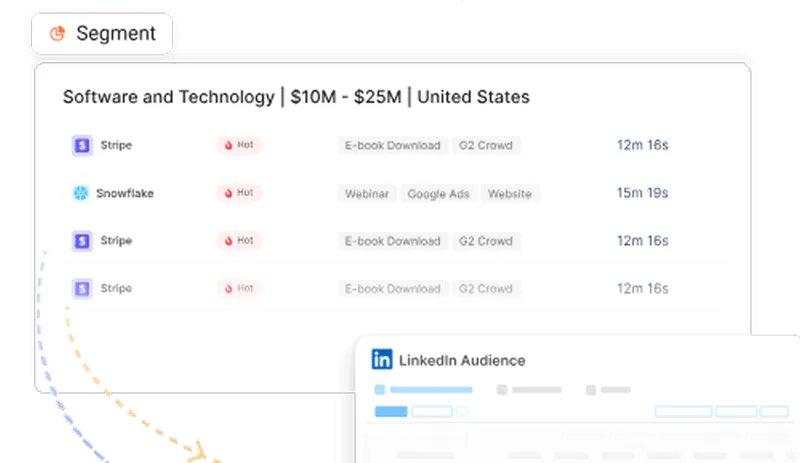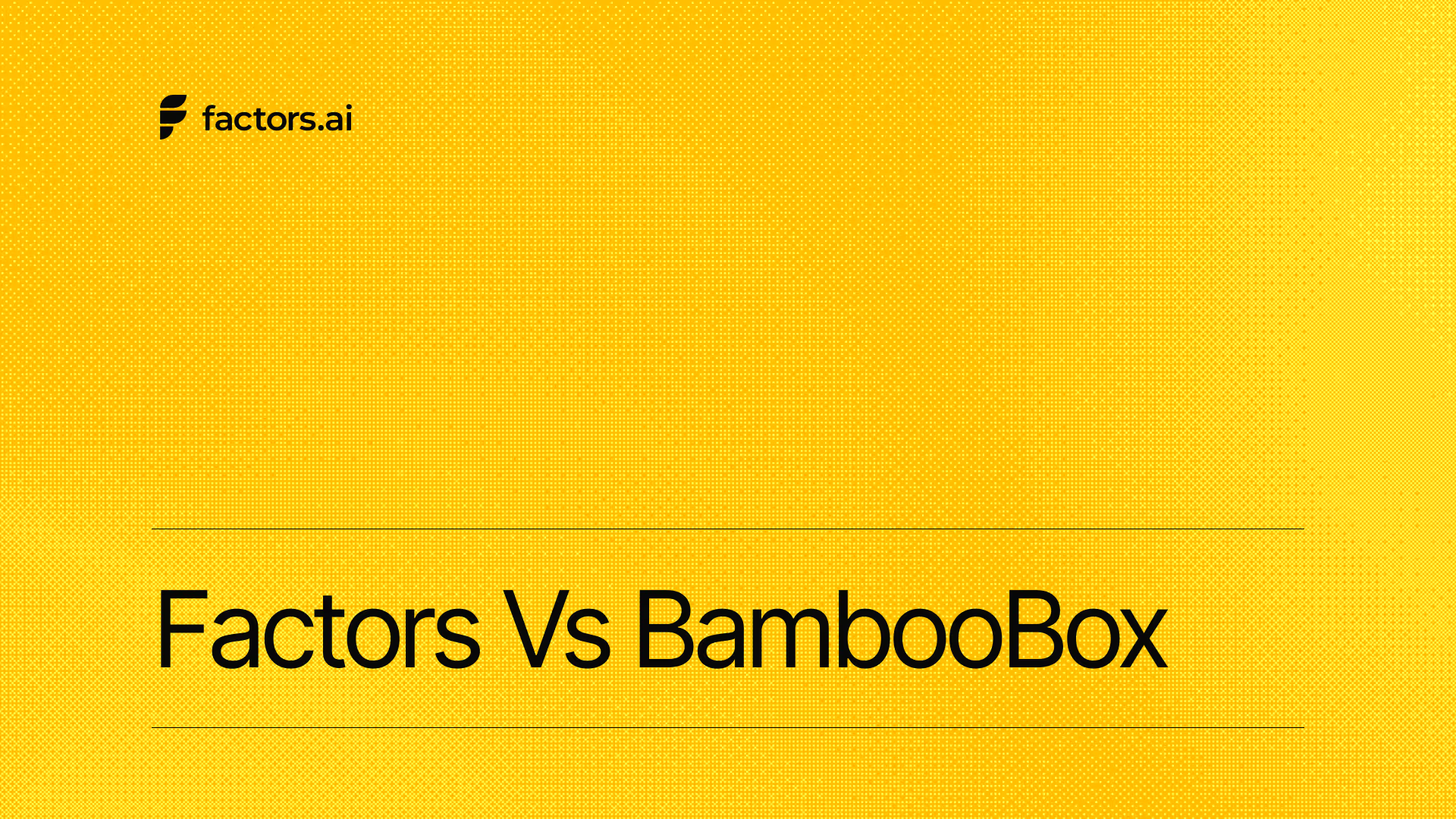Top 5 Bamboobox Alternatives for your ABM Campaigns
Want to implement account based marketing for your business? Discover the 5 best Bamboobox alternatives to take your ABM efforts to the next level.
When running an ABM campaign, you want to ensure that it reaches the right audience and drives brand consideration. Luckily, many tools are available today that can help.
Bamboobox is one such AI-powered ABM platform designed to help B2B companies streamline and enhance their demand generation and customer journey orchestration efforts.
But is Bamboobox the right choice for you? Find out as we list out the top 5 Bamboobox alternatives you can use to streamline your ABM efforts.
About Bamboobox: Features, Pros and Cons

Key Features
- ABM Campaign Orchestration: Bamboobox offers multi-channel orchestration, allowing businesses to manage ABM campaigns across various platforms, including email, social, and messaging.
- NurtureAgent: This AI-powered tool delivers personalized, one-to-one messages based on user engagement and intent, optimizing the customer lifecycle.
- Intent Signal Scoring: It captures and scores buying intent signals, helping businesses precisely target high-value accounts.
- Buyer Group Configuration: Businesses can configure buyer personas and segment audiences using over 100 attributes to create highly relevant campaigns.
- Sales and Marketing Alignment: The platform enhances collaboration by providing a unified view of buyer journeys, opportunities, and revenues.
- Continuous Improvement Tools: Bamboobox measures campaign performance, engagement, and opportunities, providing insights for ongoing optimization
Pros
- Comprehensive ABM Toolset: This tool provides a full suite of ABM features, including campaign orchestration, intent signal tracking, and buyer group management.
- Personalization: NurtureAgent ensures personalized customer interactions, enhancing engagement and conversion rates.
- Enhanced Customer Insights: Offers granular insights on engagement and intent, boosting decision-making and prioritization of high-value accounts.
Cons
- Limited API Support: Bamboobox has limited API integrations, which might restrict flexibility when connecting with other tools in a tech stack
- No Free Trial: Unlike many competitors, Bamboobox does not offer a free trial, which could be a barrier for smaller businesses or those unfamiliar with the platform.
- Complex Setup for Smaller Teams: While it’s highly customizable, the platform can be complex to configure and maintain, which might not be ideal for smaller companies without dedicated technical resources

Pricing
The pricing isn’t available on their website.
{{INLINE_CTA_A}}
Why Look for a Bamboobox Alternative
- Scalability
Some businesses may find the platform difficult to scale, particularly if they require seamless API integration with other tools.
- Cost
Bamboobox operates on a custom pricing model, which could make it less accessible for small to medium-sized enterprises.
- Usability
Due to the platform's complexity, businesses looking for more intuitive or user-friendly interfaces may opt for simpler solutions.
5 Bamboobox Alternatives in the market today
Here’s a list of five ABM platforms, each with three pros and three cons for a detailed comparison, including Factors.ai as the top choice:
1. Factors.ai

Key Features
- IP-based B2B account identification across the website, product reviews & ad impressions, with match rates powered by 6sense and Clearbit
- Account scoring, where you can create your own scoring rules to score, qualify, and segment high-intent accounts based on cross-channel engagement
- G2 and LinkedIn intent signals to identify how prospects are engaging with your profile.
- Workflow automation that allows you to push high-fit and high-intent prospects to mail sequencing tools
- Robust analytics and attribution give you a complete overview of how buyers act at each customer journey stage.
Pros
- Customizable Segmentation: Highly flexible for precise targeting across multiple segments.
- Attribution Modeling: Offers detailed insights on the effectiveness of marketing channels.
- Collaboration Tools: Encourages teamwork across marketing and sales with a shared dashboard.
Cons
Factors doesn’t offer person-level contact identification unless integrated with tools like Apollo and Zoominfo.
{{INLINE_CTA_A}}
2. Demandbase

Key Features:
- AI-powered account identification and targeting.
- Multichannel orchestration and personalized content delivery.
- Account-based advertising and intent-driven engagement insights.
Pros:
- Robust Targeting: Excellent AI-powered account targeting for precision marketing.
- Cross-Channel Support: Supports campaigns across web, email, and social.
- Sales-Marketing Alignment: Facilitates alignment between sales and marketing teams.
Cons:
- High Cost: More expensive compared to other tools, making it less accessible for small businesses.
- Learning Curve: Requires significant onboarding due to its complexity.
- Limited Customization: Some users may find restrictions when tailoring the platform to specific needs.

💡Also read: Top 5 Demandbase Alternatives to Boost ABM in 2024
3. Terminus

Key Features:
- Multichannel account-based engagement via email, display ads, and social.
- AI-driven account identification and scoring.
- Deep sales and marketing alignment features.
Pros:
- Full-Funnel Coverage: Great for running ABM campaigns from top to bottom of the funnel.
- Easy to Use: Intuitive interface that simplifies campaign setup and tracking.
- Comprehensive Account Insights: Offers strong insights into account engagement.
Cons:
- Ad Performance: Metrics for ad campaigns could be more detailed.
- Complex Setup for Smaller Companies: Requires technical expertise for advanced configurations.
- Limited Reporting Flexibility: Some users report challenges with customizing dashboards.
{{INLINE_CTA_A}}
4. 6sense

Key Features
- AI-powered predictive intelligence to identify the best time for account engagement.
- Multichannel orchestration with intent-driven marketing.
- Comprehensive dashboards for real-time data and insights.
Pros
- Advanced Predictive Analytics: Powerful AI-based predictions for better decision-making.
- High-Quality Intent Data: Captures deep insights into buyer behavior and readiness.
- Seamless Sales-Marketing Collaboration: Provides a unified view of account engagement.
Cons:
- Expensive: Premium pricing makes it inaccessible for smaller businesses.
- Steep Learning Curve: Requires a solid understanding of the platform’s features and capabilities.
5. RollWorks

Key Features
- Real-time account scoring and multichannel advertising.
- Targeting and personalization based on account data and buyer personas.
- Customer journey mapping for full-funnel ABM execution.
Pros
- Cost-Effective for SMBs: More affordable compared to other enterprise-grade ABM tools.
- User-Friendly: Easy to navigate, even for users without advanced technical expertise.
- Strong Reporting and Insights: Offers good analytics and campaign performance tracking.
Cons
- Limited Advanced Features: May lack some of the more advanced functionalities of higher-end ABM platforms.
- Requires Complementary Tools: May need additional software for deep analytics and reporting.
- Less Effective for Large Enterprises: Scalable, but not ideal for very large organizations with complex needs.
💡Also read: Top 10 RollWorks Alternatives for Effective Account-Based Marketing
Choose the best Bamboobox alternative today
As you can see, there’s a plethora of ABM platforms out there, each offering unique features and benefits. If you’re looking for a complete ABX solution, you can opt for tools like Demandbase or 6sense.
However, if you want to scale and optimize your ABM campaigns and get meaningful insights from intent signals, look no further than Factors. Book a demo today to witness the power of signal based GTM.
{{INLINE_CTA_A}}
See how Factors can 2x your ROI
Boost your LinkedIn ROI in no time using data-driven insights


See Factors in action.
Schedule a personalized demo or sign up to get started for free
LinkedIn Marketing Partner
GDPR & SOC2 Type II
.svg)







.avif)
.avif)

